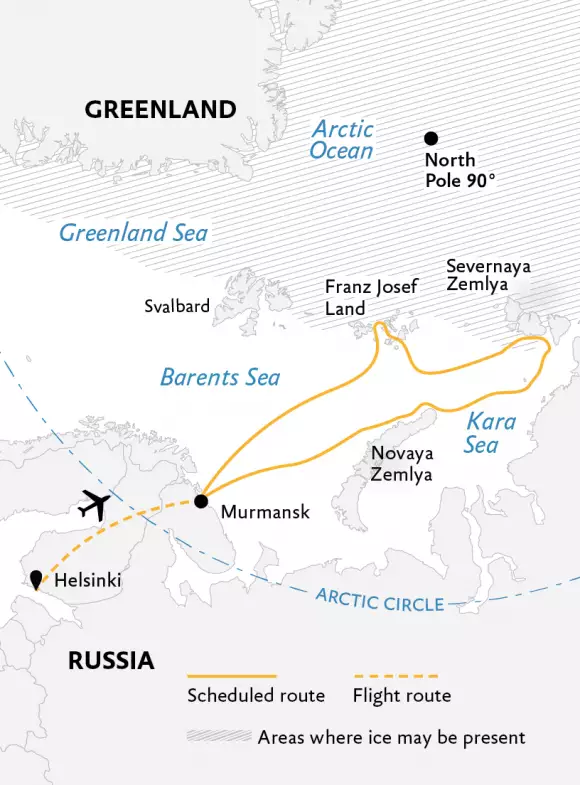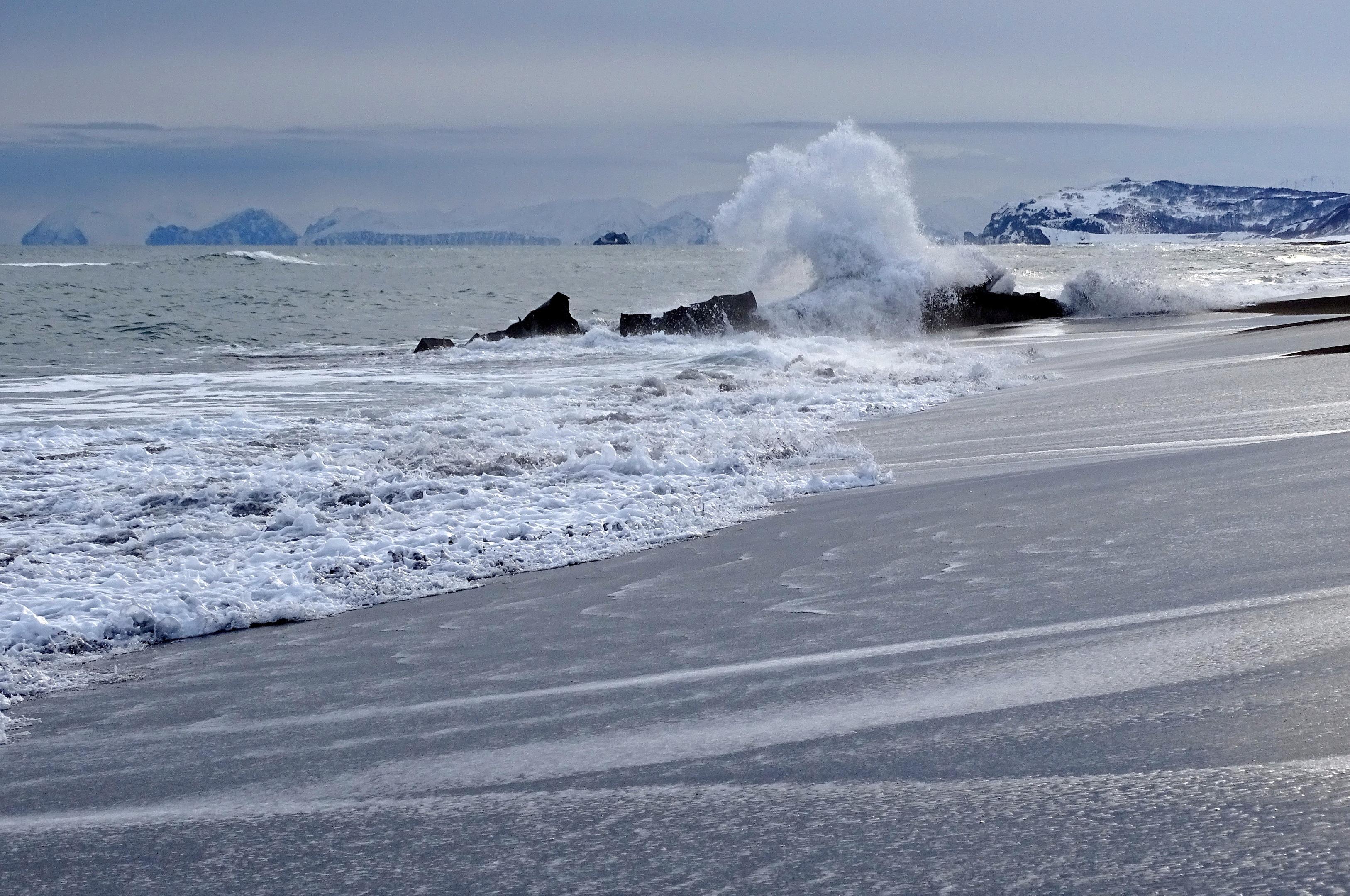One of Earth’s last regions to be discovered, and the newest destination in Quark Expeditions’ portfolio, the High Russian Arctic is a place of mystery, beauty and wonder.
On this stirring voyage along Russia’s ice-draped coastlines, we invite you to become one of the first passengers to visit this little-known region and encounter sights rarely seen by even the most intrepid adventurers.
From the breathtaking glaciers of Novaya Zemlya and Franz Josef Land to the stark, secluded islands of the icy Kara Sea, the remarkable features of this isolated wilderness will leave you awed and inspired. An incredible 22-day journey that will take you to far-flung landscapes unlike anything you’ve ever witnessed, High Arctic Odyssey is exclusively designed to allow you to maximize your time exploring these pristine environments, appreciate the rich and dramatic polar history of these faraway destinations, and, especially, increase your chances of observing the region’s diverse and magnificent wildlife, such as whales, seals, muskox, walruses and polar bears. If conditions allow, this itinerary will also include Severnaya Zemlya, the last major territorial discovery on Earth. Come aboard and venture to one of the most remote corners of the globe with the most experienced expedition team in the industry.

Your Arctic adventure begins in Helsinki, renowned for its extraordinary architecture and design scene and intriguing mix of eastern and western influences. If you arrive early, explore the many museums, galleries and restaurants, relax at a Finnish sauna or wander the vibrant Design District before retiring at your included hotel.
After breakfast, we will transfer to the airport and board our private charter flight to Murmansk, Russia. Once aboard, get acquainted with the ship and crew and settle in for your voyage north.
Today we sail through the Barents Sea, named for the great Dutch explorer Willem Barents, who led two expeditions to Novaya Zemlya in the 1590s. Your Expedition Team will prepare you for the adventures that await. Learn about the intriguing history and politics of the region, its fascinating wildlife, geology, ecology and climate, and the incredible sights you will soon explore. Expedition Staff will also keep a lookout for the seabirds, such as kittiwakes, skuas and fulmars, soaring above your ship. Whale and seal sightings may also be possible in this biologically rich sea.
The largest of the Eurasian Arctic archipelagoes, the rarely visited Novaya Zemlya (“New Land”) is the third-largest wilderness area in Europe. This seemingly long, thin island actually consists of two main islands, Severny (northern) and Yuzhny (southern), separated by the imposing Matochkin Strait. These islands are pure, rugged Arctic beauty at its best—massive extinct volcanoes, jagged ice cliffs and the most isolated mountain range in the Barents Sea.
As we explore Novaya Zemlya, expect a new adventure every day. Each expedition will be unique, depending on the weather and ice, but a few landing sites we strive to visit include Inostrantseva Bay, the Oransky Islands, Cape Zhelaniya, Cape Spory Navalok and Russkaya Gavan.
Boasting one of the most picturesque glaciers in the entire archipelago, Inostrantseva Bay provides breathtaking panoramic views of pristine Arctic wilderness. If conditions allow, we may explore ashore, or Zodiac cruise along the face of the glacier, at a safe distance, possibly witnessing the wonders of calving ice. Encounters with Brünnich’s guillemots (thick-billed murres) are likely, owing to a small colony in the coastal cliffs.
To the east of Severny Island are the Oransky Islands. Wildlife abounds here, with a variety of animal and plant life to be discovered; walrus have been sighted here on previous expeditions. Coming across a walrus haul-out is unforgettable. These giant pinnipeds of the Arctic create a raucous chorus as each walrus vies for a choice spot of coastline. Encounters with whales and seabirds are possible, as well as polar bears, a genetically distinct subpopulation here.
A significant site in polar exploration, Novaya Zemlya also offers a number of opportunities for you to trace the footsteps of famous explorers and reflect on the region’s history.
Say goodbye to Novaya Zemlya as we cruise farther east, exploring the Kara Sea. The westernmost Asian sea off Siberia, the Kara Sea is known as the “ice cellar” of the Arctic, as it is often encumbered by trapped ice floes. Ice conditions will be considered by your skilled captain during navigation—luckily sea ice happens to be a great habitat for iconic Arctic wildlife. There are several sites and small archipelagoes along the Siberian coast we hope to explore, tracing the path of polar explorers searching for the Northeast Passage. Weather and ice will determine where we explore, but some areas we hope to visit include Russky Island, Troynoy Island and Cape Chelyuskin.
Both Russky Island and Troynoy Island are part of the Great Arctic State Nature Reserve, the largest reserve in Eurasia. Russky Island is the site of a former polar station, established, in part, to monitor navigation along the Northern Sea Route, the Russian section of the Northeast Passage.
Troynoy Island is the largest of the Izvesti Tsik Islands, about 90 miles (150 km) off the coast of the Taymyr Peninsula. The island is uninhabited, except for the researchers at the weather station. Home to an ivory gull colony, the island is also frequented by polar bears.
At the tip of the Taymyr Peninsula is Cape Chelyuskin, the northernmost point of the Russian and Eurasian mainland and the site of another active research station. Here, at “the edge of the earth,” we hope to explore on foot.
Dependent on ice and weather conditions, an exploration of Severnaya Zemlya embodies the true spirit of adventure. Dominated by glaciers and polar desert, the archipelago was not discovered until 1913 and remained virtually unexplored till 1930–32, the last major undiscovered territory on earth. Amongst many possible destinations, we hope to visit a number of glaciers, including the Vavilov Ice Cap and those at Marat Fjord. If conditions are favorable, we may cruise the Red Army Strait, flanked by the massive Academy of Sciences Glacier (which also runs along the eastern shore of Zhuravlev Bay) and the smaller Rusanov Glacier. As one of very few people to ever explore this remote area in depth, you’ll want to have your camera ready to capture these amazing sights.
There are several activities to keep you engaged while at sea. Attend dynamic presentations by your Expedition Team, relax in our polar library or simply spend some time on deck, admiring the sea and searching for wildlife.
This remote group of approximately 200 islands, many ice covered, forms the most northerly archipelago in Eurasia and lies entirely within the Arctic Circle. A nature reserve, it is part of the Russian Arctic National Park. Our exploration of the region is highly determined by weather and ice conditions, but we hope to explore historical sites, remote seabird colonies and walrus rookeries such as Cape Flora, Cape Norway, Bell Island and Tikhaya Bukta. Polar bear encounters are also probable.
On Jackson Island, Cape Norway is where Norwegian explorers Fridtjof Nansen and Hjalmar Johansen wintered from 1895 to 1896. The conditions were astonishingly difficult, but they survived until the summer and continued their journey south. The remains of their stone hut are still here today, with a memorial marking the event.
Exploring Tikhaya Bukta (Calm Bay), the site of an abandoned weather station on Hooker Island, is a step back in time. There is plenty to discover as you wander the ruins, immersed in Russian polar history. As this station is now seasonally used by the national park rangers, you may even be able to send a postcard from the post office!
Another possible landing site, if time and weather permit, is Cape Tegetthoff on Hall Island, where we hope to visit the remains of a historic base. The scenery here is spectacular, and we may be fortunate to view polar bears and Atlantic walrus.
As your Arctic expedition winds down, you have a couple of days to sail through this wildlife-rich sea, where whales of various species are often seen. Take in a presentation, reminisce about your journey with your shipmates, relax in the lounge while swapping stories and photos or enjoy the solitude of the sea. Expedition staff will be on hand to answer any questions and spot wildlife.
Returning to Russia’s most northerly city, you’ll have time to bid farewell to your Expedition Team and crew before catching our group charter flight back to Helsinki, where you will have one more night in this exquisite city.
After breakfast, spend time exploring more of the Finnish capital or catch your homeward-bound flight.
Reminder
MANDATORY TRANSFER PACKAGE INCLUDES:
- One night’s pre- and post-expedition airport hotel accommodation in Helsinki
- Round-trip flights from Helsinki to Murmansk
- Transfers to and from the ship in Murmansk
PACKAGE PRICE: $1,995 USD
Important reminder: Embracing the unexpected is part of the legacy—and excitement—of expedition travel. When traveling in extremely remote regions, your expedition staff must allow the sea, the ice and the weather to guide route and itinerary details. This itinerary is a tentative outline of what you’ll experience on this voyage; please be aware that no specific itinerary can be guaranteed.

